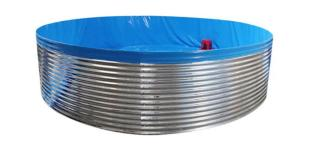Efficient and environmentally friendly? The fish pond built with this new material is beautiful and can be used for bree
quaculture is very common in areas with sufficient water resources. Many people in rural areas choose to raise fish in earthen ponds. However, many people have a problem after planting fry. After planting fry, there are not so many adult fish. Many fry No trace. The pond is a natural breeding place with a relatively rich ecological chain. There are also other organisms in the pond. When the fry are small, they do not have the ability to "fight" with them, which will cause farmers to waste breeding costs.

This situation can be alleviated by artificial ponds. The ecosystem of artificial ponds is not as complete as that of natural ponds and is relatively controllable. The breeding size, breeding density, breeding water level, etc. of the galvanized sheet canvas fish pond can all be determined according to the types of aquatic products and the breeding personnel. The galvanized sheet canvas fish pond is a soilless culture without silt soil, so there will be no unknown organisms hiding. Small fish can be eaten inside, and there is no need to carry out dredging and pond clearing during the breeding process.
Canvas fish pond is an artificial breeding pond built by a combination of galvanized sheet brackets and fish pond canvas. Compared with artificial breeding ponds made of cement ponds and other materials, the cost is lower, the construction process is relatively simple, and it takes less time. Because the fish pond is made of waterproof fabric, there will be no other organisms living in it except some microorganisms and algae. It will be easier for the fry to survive in it. Of course, this also depends on the technical experience of the fish breeders to raise the fry. It is only relatively There are fewer external threats.
Each canvas fish pond is a separate individual, and the number of seedlings in each pond can be clearly recorded. It is also convenient for comparison during the final fishing, and it is convenient to accumulate and analyze breeding technology experience. Once something happens in breeding, because they are separate individuals, they will not infect all farmed fish, which can reduce breeding losses.

Tel.: +86 17864390557





